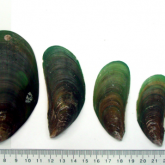Asian green mussel
Alert
Be on the lookout for Asian green mussel.
Report sightings
- Report online
- Contact us online, by phone or in person
- Call Biosecurity Queensland on 13 25 23.

Asian green mussels
© Queensland Government

Asian green mussel with size scale
© Queensland Government

Asian green mussels cluster
© Queensland Government

Asian green mussels on hull
© Queensland Government

Eight Asian green mussels of different sizes with size scale
NT Government
Asian green mussel is an invasive and prohibited marine pest. It has been detected in Weipa, Far North Queensland. It was previously confirmed in several Queensland locations. These locations include Mornington Island, Escape River, and Trinity Inlet Cairns.
Investigations into the most recent suspected detection are ongoing, however, no populations are currently known to exist in the environment, and it is considered exotic to Australia.
Asian green mussel can be introduced via ship's ballast water, as biofouling on boat hulls and through internal seawater systems.
The Asian green mussel is bright green when young and dark green to brown when mature, they are fast-growing and able to tolerate a wide range of conditions. They can spread rapidly in new locations, particularly where local predators are limited. They form dense populations, up to 35,000 individuals per square metre on a variety of hard marine structures.
It is illegal to import, or in any way deal with Asian green mussel. You must report any suspected sightings to Biosecurity Queensland.
Scientific name
Similar species
- Septifer bilocularis, Perna canaliculata (NZ green mussel)
Description
- A large mussel, often growing to 10cm and occasionally reaching 18cm in size.
- Juvenile shell is bright green.
- Adults tend to retain the green colour along the growing edge only, developing an olive or brown colouration nearer to the attachment point.
- Shell exterior is smooth with concentric growth rings and finely pitted ridge for ligament attachment.
- Shell interior is smooth, iridescent pale blue to green.
- Shell beak has interlocking teeth (1 in right valve, 2 in left).
- Posterior is wavy, adductor muscle is large and kidney-shaped.
Habitat
- Prefers warm estuarine (salty) waters.
- Can survive for short periods in cool or less salty waters.
- Prefers hard surfaces.
- Settlement is greatest from 0–10m depth.
Distribution
- Not yet established in Queensland.
Life cycle
- Fertilised eggs form larvae, which exist in plankton for up to 55 days before settling.
- Animal develops after settling and lives for about 2 years.
Impacts
Environmental
- Out-competes native species.
- Fouls hard surfaces, including vessel hulls, seawater systems, industrial intake pipes, wharves, artificial substrates and buoys.
- Accumulates high concentrations of toxins and heavy metals, which can cause shellfish poisoning if eaten by humans.
Economic
- Fouls hard surfaces, including vessel hulls, seawater systems, industrial intake pipes, wharves, artificial substrates and buoys.
Social
- Accumulates high concentrations of toxins and heavy metals, which can cause shellfish poisoning if eaten by humans.
Control
- Slipway operators, vessel inspectors and vessel owners should thoroughly check, clean and, where possible, dry vessel hulls and niche areas such as internal seawater systems.
- Early detection is essential for preventing pest establishment. If you have seen Asian green mussels, immediately contact Biosecurity Queensland on 13 25 23.
Legal requirements
- Asian green mussel is a prohibited marine animal under the Biosecurity Act 2014.
- All sightings of Asian green mussels must be reported to Biosecurity Queensland within 24 hours.
- By law, everyone has a general biosecurity obligation (GBO) to take all reasonable and practical steps to minimise the risk of Asian green mussels spreading until they receive advice from an authorised officer.
Further information
- Contact us online, by phone or in person.